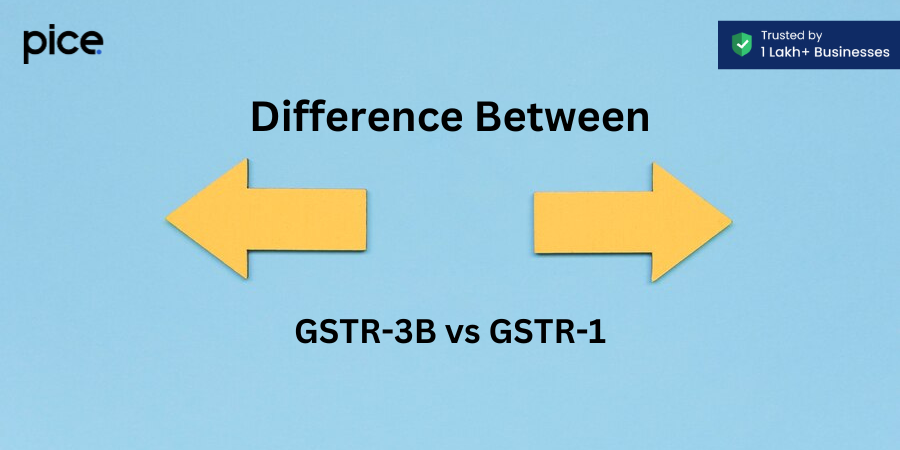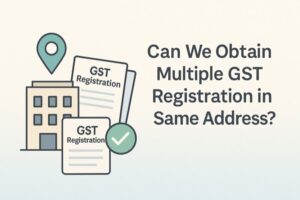Comparison of GSTR-3B vs GSTR-1: Importance, Reconciliation & Report
- 24 Aug 24
- 10 mins

Comparison of GSTR-3B vs GSTR-1: Importance, Reconciliation & Report
- What Does a GST Return Mean?
- Reconciliation Between GSTR 3B and GSTR 1
- Who Needs to File a GSTR 1?
- Who Needs to File a GSTR 3B?
- What Are the Main Differences Between GSTR-1 and GSTR-3B?
- Importance for GSTR-3B vs GSTR-1
- Reasons for Mismatches in GSTR-3B vs GSTR-1
- Actions on Reconciliation of GSTR-3B vs GSTR-1
- Advantages of GSTR-3B vs GSTR-1 Tax Comparison Report
- Conclusion
Key Takeaways
- Mandatory GST Returns: GSTR-1 details outward supplies and tax liabilities, while GSTR-3B is a summary return of monthly transactions.
- Reconciliation: Cross-checking GSTR-1 and GSTR-3B is crucial to avoid penalties, interest, and discrepancies in tax payable.
- Filing Deadlines: GSTR-1 deadlines vary based on turnover, while GSTR-3B is due by the 20th of each month for all registered taxpayers.
- Importance of Accuracy: Correct and timely reconciliation prevents show cause notices, GSTIN suspension, and ensures accurate tax allocation.
- Potential Mismatches: Common reasons for discrepancies include incorrect reporting tables, post-filing amendments, and typographical errors
The introduction of the Goods and Services Tax (GST) has made India’s tax system more streamlined since this is a one-stop solution in the form of a single tax. In compliance with GST, it is mandatory to file monthly and quarterly returns, which include GSTR-1 and GSTR-3B.
This guide will cover the details of GST return filing, the difference between GSTR-1 and GSTR-3B, the significance of reconciliation, who is required to submit these returns, and more.
What Does a GST Return Mean?

A GST return is a statement that you must submit to tax authorities under the GST regime. It contains details of your revenues, including your purchase, sale, taxes paid and collected. These returns are vital for complying with GST regulations and are necessary for calculating the taxpayer's tax obligations accurately.
A delay in the filing of returns can lead to penalties. For instance, if a business with an annual turnover of up to ₹5 crore delays in filing of GST returns, it incurs a late fee of ₹50 per day, up to a maximum limit of 0.04% of the business turnover.
Reconciliation Between GSTR 3B and GSTR 1
If there are disparities between GSTR 3B and GSTR 1 returns for different months, taxpayers can attract interest or penalty charges for delayed returns to cover the tax balance. Therefore, it is advisable for taxpayers to cross-check GSTR 3B with GSTR 1 for every filing period to reduce the error rate.
This proactive approach not only facilitates correct annual return filing but also aligns with the unified system for all GST returns.
According to Rule 88C, taxpayers will be notified in Part A of Form GST DRC-01B if the tax payable reported in GSTR-1/Invoice Furnishing Facility (IFF) exceeds that in GSTR-3B by a specified amount and percentage. This rule applies only when there is a discrepancy in tax payable between GSTR-1 and GSTR-3B meeting the prescribed criteria.
Any discrepancies could lead to fines, penalties or even cancellation of GST registration, highlighting the importance of meticulous reconciliation.
Who Needs to File a GSTR 1?

Every registered dealer has to pay GSTR 1 returns, irrespective of their turnover or any transaction made during a month. This requirement is mandatory even if there is no business being done in a certain month, or even if no sales have been made. However, certain entities and individuals are exempt from filing GSTR 1:
- Composition Scheme Businesses: Businesses registered under the composition scheme as per GST regulations, applicable to entities with an annual turnover of up to ₹1.5 crores starting from April 1, 2019.
- Input Service Distributors: Input service distributors under GST norms, specifically those receiving invoices for services accessed by other branches,.
- Suppliers of Online Services: Suppliers of retrieval services, database access and online information.
- Non-resident Taxable Person: Non-taxable persons who import goods and services from outside India or manage business activities on behalf of non-resident Indians.
To file GSTR 1, one must have a valid Goods and Service Tax Identification Number (GSTIN), user ID and password for the GST portal, digital signature certificate and Aadhar number. Additionally, access to the mobile number registered with Aadhar is also necessary.
Who Needs to File a GSTR 3B?
All taxpayers under the GST regime must file GSTR 3B, irrespective of whether they have a high or low volume of monthly transactions. However, certain categories of taxpayers are exempt from filing GSTR 3B:
- Composition dealers
- Input service distributors
- Suppliers of retrieval services, database access, or online information
- Non-resident, taxable Indians
The GSTR 3B form requires taxpayers to summarise their purchases and sales information, report all available ITCs (Input Tax Credits), declare tax payables and detail the tax they have already paid.
What Are the Main Differences Between GSTR-1 and GSTR-3B?
Go through the following table to understand the key difference between GSTR-1 and GSTR-3B:
| Parameters | GSTR-1 | GSTR-3B |
| Meaning | GSTR-1 is a return that taxpayers must file either quarterly or monthly. It details their outward supplies and tax liabilities for the period, allowing the government to track each transaction and enabling recipients to claim input tax credits. | GSTR-3B is a monthly summary return that all regular taxpayers are required to file. It serves as a self-declaration of tax liability for the respective tax period and must be filed even if there are no outward supplies during that period. |
| Details to be included | Includes detailed information on outward supplies, individual invoices and tax liabilities for the period | Includes summarised information about outward supplies, input tax credit (ITC) claims, and tax payments |
| Filing date | Monthly filers (turnover above ₹1.50 crore): Due by the 11th of the following month. Quarterly filers (turnover below ₹1.50 crore):Due by the 30th or 31st of the month following the quarter-end. | All registered businesses must file GSTR-3B monthly, with the deadline set as the 20th of each month. |
| Tax payment | No tax payment is required at the time of GSTR-1 filing. | Tax liabilities must be settled before GSTR-3B filing. |
| Penalty for not filing or late filing | ₹200 per day (₹100 each for CGST and SGST) | ₹20 per day for nil returns ₹50 per day for returns with transactions |
Importance for GSTR-3B vs GSTR-1
Reconciling GSTR-3B and GSTR-1 is essential for several reasons:
- Preventing Show Cause Notices: GST authorities have issues show cause notices to taxpayers, highlighting the necessity of matching the total sales reported in GSTR-3B along with the detailed information in GSTR-1.
- Ensuring Accuracy: Reconciliation helps ensure that invoices are not deleted nor duplicated in GSTR-3B or GSTR-1 returns, thus leading to accuracy in the calculation of the tax payable on sales.
- Avoiding GSTIN Suspension: From January 1, 2021, the supplies declared in GSTR-1 should align with the total supplies in GSTR-3B. Discrepancies can result in the suspension of the GSTIN.
- Correct Revenue Distribution: Reconciliation aids the government in accurately allocating tax revenue to the appropriate states and finding mistakes in the integrated tax details in GSTR-3B.
- Seamlessly Claim Input Tax Credit: GSTR-1 is the basis for recipients to claim input tax credits. On-time and correct reporting in both GSTR-1 and GSTR-3B helps avoid future issues for recipients and guarantees legitimate input tax credit claims. Prioritising reconciliation helps businesses minimise risks, stay compliant and maintain hassle-free GST framework operations.
- Avoiding Interest on Late Declarations: Late declaration of GST liability can incur interest, making timely reconciliation crucial to avoid extra costs.
Reasons for Mismatches in GSTR-3B vs GSTR-1

The details mentioned in Form GSTR-3B and GSTR-1 often do not reconcile due to several reasons, which are as follows:
- Incorrect Reporting Tables: Supplies might be reported under the wrong table in GSTR-3B but correctly in GSTR-1. For example, zero-rated sales might be correctly reported in Table 6A of GSTR-1 but mistakenly listed under Table 3.1(a) in GSTR-3B.
- Not Mentioning Inter-state Supplies: Inter-state supplies which are made to unregistered persons are declared in GSTR-1 but deleted in GSTR-3B.
- Post-filing Amendments: Supplies may be amended after GSTR-1 has been filed, causing discrepancies between the initially filed GSTR-1 and the later filed GSTR-3B.
- Incorrect Tax Head: The supply values might be correctly displayed, but the tax you have paid is shown under the wrong head, such as paying CGST instead of SGST and IGST, or vice versa.
- Debit or Credit Notes Issued Later: An invoice issued in one month with a debit or credit note issued later can cause mismatches.
- Reporting Time Lag: A time lag in reporting invoices in GSTR-1 and GSTR-3B can lead to inconsistencies.
- Typographical Errors: Typographical mistakes in reporting can also lead to discrepancies.
Actions on Reconciliation of GSTR-3B vs GSTR-1
If you find any difference between GSTR-1 and GSTR-3B forms across different months that results in a tax shortfall by the supplier, you must pay the owed amount along with interest. Therefore, it is essential to reconcile these forms for every filing period to ensure they match and avoid any interest payments later on.
Advantages of GSTR-3B vs GSTR-1 Tax Comparison Report
The following are the benefits of comparing GSTR-3B and GSTR-1 reports:
- Download the Forms Anytime: You can download GSTR-3B and GSTR-1 at any time across months and provide your sales ledgers to perform a comparison of data.
- Smoothly Update Information: After verifying your GST login with an OTP, you can seamlessly update data with just a click, from anywhere at any time.
- Easily See the Differences: Check differences in every field, including outward taxable value, outward tax, and supplies under the Reverse Charge Mechanism, in both GSTR-3B and GSTR-1 returns.
- Compare Data: Data comparison is available at both the PAN and GSTIN levels.
- Immediate Discrepancy Overview: Instantly see differences on either a monthly basis, quarterly basis, or annual basis to take the necessary actions.
Conclusion
Understanding the difference between GSTR-1 and GSTR-3B is essential for businesses under the GST regime. It is crucial for businesses to fully grasp the filing requirements of GSTR-1 and GSTR-3B to adhere to GST regulations in India. These returns are pivotal in maintaining transparency within the tax system and ensuring that taxpayers meet their tax responsibilities with precision and timeliness.
💡Learn more about how our Pice app can help you make all your important business payments, like supplier and vendor payments, rent, GST, & utility, from one single dashboard with your credit card. Request a demo now.
 By
By 

















